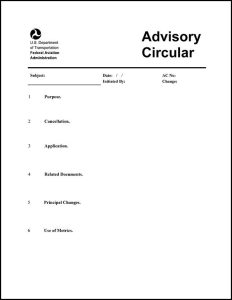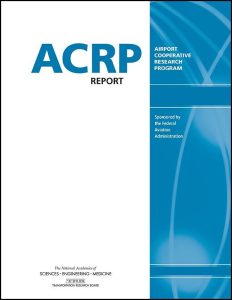To narrow the library of airside resources, use the filter boxes or airport map below or search box above.
Click an item below to expand.
Resources Matching Your Search
2017
This advisory circular (AC) establishes a common, uniform definition of critical aircraft for all deliberations of the FAA Office of Airports, inclusive of planning and environmental, design and engineering, and financial decision-making regarding airport development.
2019
ACRP Research Report 192 is designed to assist airports that are considering self-providing fueling services or currently providing them directly to their customers. The report includes a methodology to help evaluate whether an airport should or should not provide fuel service, a checklist of action items required for providing fuel service, and a sample request for proposals to solicit bids from fuel suppliers. The report also addresses a wide range of topics, including feasibility evaluations for new or improved fueling facilities, fuel pricing and marketing strategies, and organizational considerations when starting or expanding a fueling service.
2019
ACRP Research Report 195 is designed to assist airport operators in developing and implementing an obstruction management program to protect the airport airspace from encroachment by tall objects. The report will help airport staff develop an obstruction management plan by understanding the regulatory environment, identifying obstructions, and developing a strategy for communication with surrounding communities that will ensure airport involvement in any development issues that could result in an obstruction around the airport. The report is supplemented by ACRP WebResource 7: Best Practices for Airport Obstruction Management Library, which provides reference documents, model documents, and presentation materials for obstruction management outreach. A methodology for creating a composite map of all applicable airspace surfaces as well as examples of interactive airspace composite surface maps for small and large airports are also provided.
2021
This resource is a webpage that provides information on the Electronic Code of Federal Regulations (e-CFR) Title 14, Chapter I, Subchapter G, Part 139, which contains guidance on certification, airport certification manual, and operations.
2021
This resource is a webpage that provides information on the Electronic Code of Federal Regulations (e-CFR) Title 14, Chapter I, Subchapter I, Part 150, which contains guidance on Part 150: Airport Noise Compatibility Planning including general provisions, development of noise exposure maps and noise compatibility programs, and evaluation and determinations of effects of noise compatibility programs.
2021
This resource is a webpage that provides information on the Electronic Code of Federal Regulations (e-CFR) Title 14, Chapter I, Subchapter E, Part 77, which contains guidance on the safe and efficient use as well as the preservation of the navigable airspace.
2021
This resource is a webpage that provides information on the Electronic Code of Federal Regulations (e-CFR) Title 19, Chapter I, Part 122, which address air commerce regulations. Subpart B addresses the various classes of international airports.
2021
This resource is a webpage that provides information on the Electronic Code of Federal Regulations (e-CFR) Title 49, Subtitle B, Chapter XII, Subchapter C, Part 1540, which applies to persons engaged in aviation-related activities, including holders of TSA-approved security programs.
2021
This webpage contains four subparts that describe aviation security rules governing 1) the operation of airports regularly serving aircraft operations required to be under a security program under Part 1544 of this chapter, as described in this part; 2) the operation of airports regularly serving foreign air carrier operations required to be under a security program under Part 1546 of this chapter, as described in this part; 3) each airport operator that receives a security directive or information circular and each person who receives information from a security directive or information circular issued by the designated official for civil aviation security; and 4) each airport operator that does not have a security program under this part that serves an aircraft operator operating under a security program under Part 1544 of this chapter, or a foreign air carrier operating under a security program under Part 1546 of this chapter—both must comply with §1542.5.
2021
This resource is a webpage that provides information on the Electronic Code of Federal Regulations (e-CFR) Title 49, Subtitle B, Chapter XII, Subchapter C, Part 1544, which prescribes the rules governing the operations of aircraft operators holding operating certificates under 14 CFR part 119 for scheduled passenger operations, public charter passenger operations, private charter passenger operations; the operations of aircraft operators holding operating certificates under 14 CFR part 119 operating aircraft with a maximum certificated takeoff weight of 12,500 pounds or more; and other aircraft operators adopting and obtaining approval of an aircraft operator security program. Security for cargo operations is governed by this regulation.
2021
This resource is a webpage that provides information on the Electronic Code of Federal Regulations (e-CFR) Title 49, Subtitle B, Chapter XII, Subchapter C, Part 1549, which applies to each facility applying for or certified by TSA as a certified cargo screening facility to screen cargo.
2021
This resource is a webpage that provides information on the Electronic Code of Federal Regulations (e-CFR) Title 49, Subtitle B, Chapter XII, Subchapter C, Part 1550, which applies to the operation of aircraft for which there are no security requirements in other parts of this subchapter.
1983
This advisory circular (AC) provides guidance for noise control and compatibility planning for airports under Federal Aviation Regulation (FAR) Part 150 and the Aviation Safety and Noise Abatement Act of 1979 (ASNA) (P.L. 96-193). It is intended for use by airport operators, state and local planners and other officials, and interested citizens who may engage in noise control planning.
2006
This advisory circular (AC) provides basic information pertaining to the FAA's recommendations on commercial minimum standards and related policies. Although minimum standards are optional, the FAA highly recommends their use and implementation as a means to minimize the potential for violations of federal obligations at federally obligated airports.
2009
This advisory circular (AC) provides guidance to the airport operator in the development and implementation of an airport emergency plan (AEP). The AEP addresses essential emergency-related and deliberate actions planned to ensure the safety of and emergency services for the airport populace and the community in which the airport is located.
2018
For certificated airports, this advisory circular (AC) defines the minimum acceptable standards for the conduct and preparation of wildlife hazard site visits, assessments, and management plans. This AC provides guidelines that discuss whether a site visit can be conducted or whether an assessment must be conducted under Part 139. In the case of airports that are not Part 139 certificated, this AC provides guidelines as to when a site visit or assessment is recommended. The AC further defines and explains continual monitoring programs. This AC also provides checklists to help people evaluate site visits, assessments, and plans.
2015
This advisory circular (AC) and its appendices provide guidance to airport operators about developing training programs for safe ground vehicle operations, personnel taxiing or towing an aircraft, and pedestrian control on the movement and safety areas of an airport. This version represents a major rewrite.
2004
This advisory circular (AC) provides methods acceptable to the administrator for showing compliance with the Airport Certification Manual requirements in Title 14, Code of Federal Regulations (CFR) Part 139, Certification of Airports.
2014
This advisory circular (AC) provides guidance to assist airport operators in the procurement of snow and ice control equipment for airport use. The use of this AC is mandatory for all projects funded with federal grant monies through the Airport Improvement Program (AIP) and/or with revenue from the Passenger Facility Charge (PFC) Program. Equipment addressed include high-speed rotary plows, snow plows, material spreaders, runway brooms and carrier vehicles.
2021
This advisory circular (AC) contains specifications and guidance for the storage, handling, and dispensing of aviation fuel on airports. It also provides standards and guidance for the training of personnel who conduct these activities.


